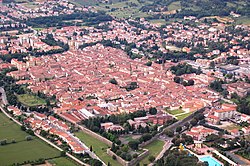Sansepolcro
Sansepolcro | |
|---|---|
| Città di Sansepolcro | |
 Aerial view of Sansepolcro. | |
| Country | Italy |
| Region | Tuscany |
| Province | Arezzo (AR) |
| Frazioni | Aboca, Gragnano, Gricignano, Melello, Montagna, Santa Fiora |
| Government | |
| • Mayor | Mauro Cornioli |
| Area | |
• Total | 91.48 km2 (35.32 sq mi) |
| Elevation | 330 m (1,080 ft) |
| Population (31 December 2014)[2] | |
• Total | 16,012 |
| • Density | 180/km2 (450/sq mi) |
| Demonym | Biturgensi |
| Time zone | UTC+1 (CET) |
| • Summer (DST) | UTC+2 (CEST) |
| Postal code | 52037 |
| Dialing code | 0575 |
| Patron saint | St. John the Evangelist |
| Saint day | December 27 |
| Website | www |
Sansepolcro, formerly Borgo Santo Sepolcro, is a town and comune in Tuscany, Italy, in the province of Arezzo.
Situated on the upper reaches of the Tiber river, the town is the birthplace of the painters Piero della Francesca, Raffaellino del Colle (a pupil of Raphael), Santi di Tito, and Angiolo Tricca. It was also the birthplace of the Italian mathematician Luca Pacioli, and of Matteo Cioni, who translated into Latin Piero della Francesca's treatise about perspective in painting (De Prospectiva Pingendi).
Today, the economy is based on agriculture, industrial manufacturing, food processing and pharmaceuticals. It is the home of Buitoni pasta, founded by Giulia Buitoni in 1827.
History
According to tradition, the town was founded around 1000 AD by two pilgrims, Arcanus and Aegidius, who brought a stone from the Church of the Holy Sepulchre (thus, San Sepolcro) with them from the Holy Land. They founded an oratory dedicated to Saint Leonard, on the site of the current Cathedral.
The first historical mentions of Sansepolcro are slightly later, referring to the Benedictine Abbey, the "Badia", around which the walled commune clustered. During the conflicts between Guelfs and Ghibellines, the town's factions were headed by prominent local families, including the Pichi, Bercordati, Graziani and Bacci.[3]
The city was ruled from Citta' di Castello, Milan, then by the Papacy; in 1367 Pope Urban V gave the town and its surrounding contrada to Galeotto Malatesta family, whose heirs ruled it until control was assumed by Florence.
During World War II the town was saved from destruction by the efforts of Tony Clarke, a British Royal Horse Artillery officer who halted the Allied artillery attack in order to save Piero della Francesca's fresco Resurrection.[4]
Main sights
The main church is the Cathedral, built in Gothic-Romanesque style in 1012–49. Other churches of note are San Francesco and San Lorenzo. The latter church has a Deposition by Rosso Fiorentino.
The English writer Aldous Huxley described the Resurrection by Piero della Francesca, which is in the Museo Civico, as "the greatest painting in the world". The museum collection includes three other works by Piero della Francesca and many other treasures including paintings by Santi di Tito, Raffaellino del Colle and Luca Signorelli.
See also
International relations
Twin towns – Sister cities
Sansepolcro is twinned with:
Notes
- ^ "Superficie di Comuni Province e Regioni italiane al 9 ottobre 2011". Italian National Institute of Statistics. Retrieved 16 March 2019.
- ^ "Popolazione Residente al 1° Gennaio 2018". Italian National Institute of Statistics. Retrieved 16 March 2019.
- ^ Marilyn Aronberg Lavin, Piero della Francesca 2002:14.
- ^ http://www.bbc.co.uk/news/magazine-16306893

